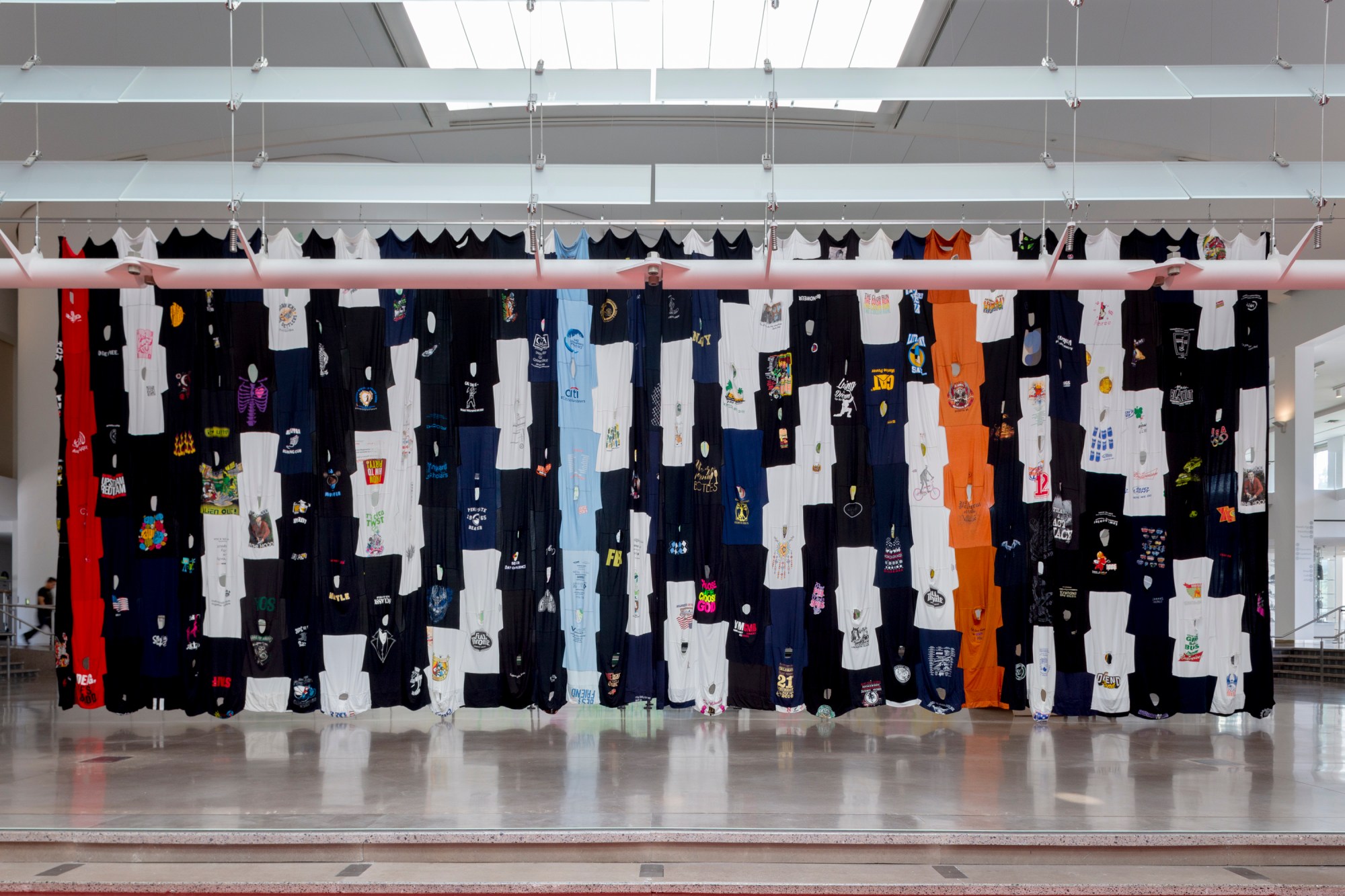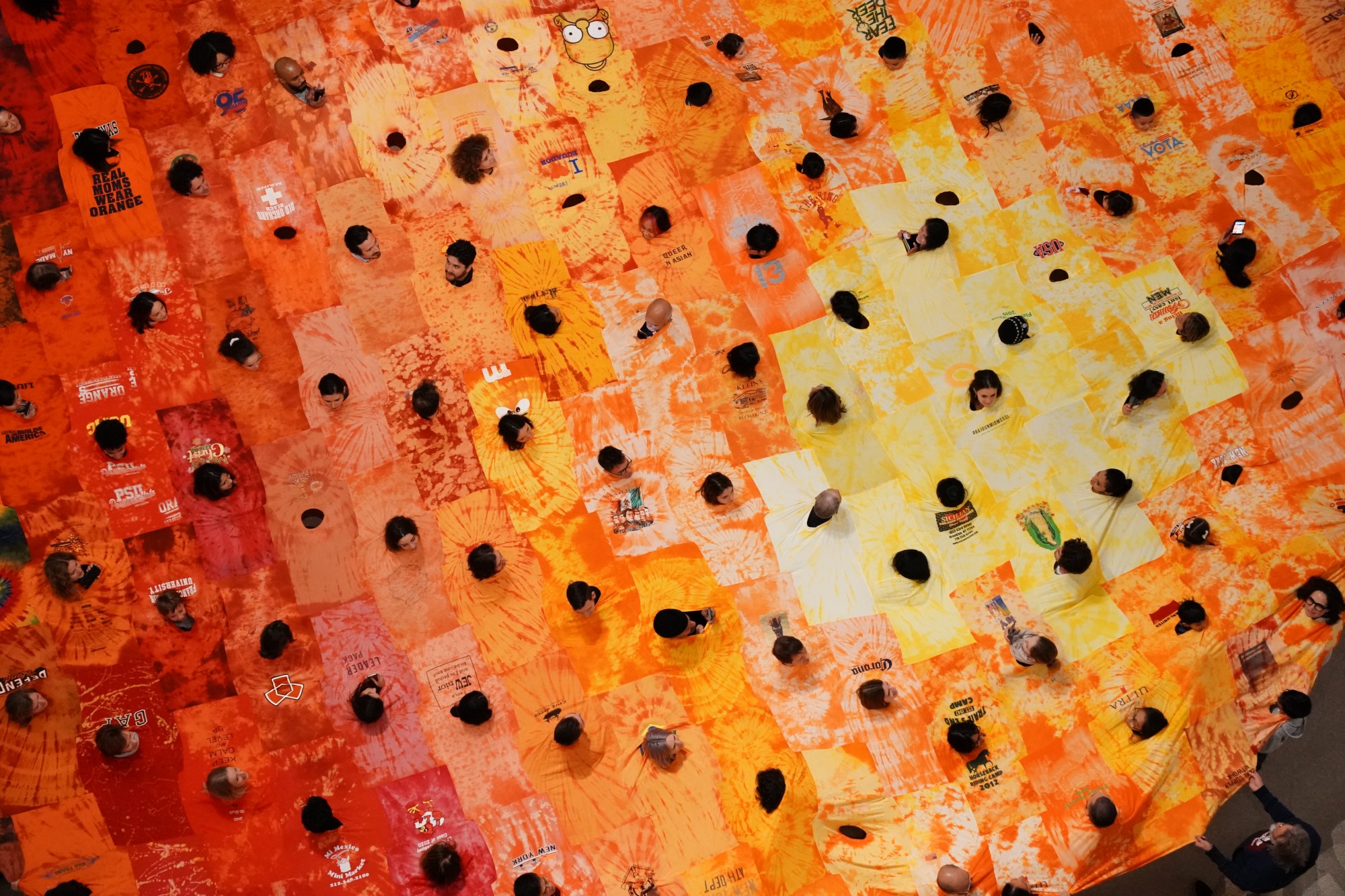Artist Pia Camil makes work in a way that’s layered and interwoven, using fabric and clothing, sculpture, and performance as a means to reference the body and our collective humanity. For example, for her current exhibit, “Fade into black: sit, chill, look, talk, roll, play, listen, give, take, dance, share” at the Queens Museum in New York, recycled t-shirts and jeans, which have been collected from international markets, have been sewn together as curtains and soft sculptures visitors can use for lounging.
Confronting global consumerism, the artist sees these objects as means for discussing sociopolitical issues as well as production and distribution — or as the press release describes, it is “inspired by the open-air markets of Latin America, particularly Iztapalapa in Mexico City, the artist references the cycle in which shirts designed in the US are manufactured in Latin America or Southeast Asia, worn and discarded in the United States, and then sent back to Latin America to be sold again in second-hand markets, where their logos advocate for causes far removed from local culture.” In other words, it’s a commentary on border relations and socioeconomic conflicts, calling into question the re-importing of goods like t-shirts and the ways in which they “haunt” their places of origin.

Connecting with the community is another factor of her work. In fact, Camil recently orchestrated an interactive site-specific work at the Guggenheim, called “Here Comes The Sun” in which young people performed as part of an installation where the t-shirts were woven together to represent the fabric of society. “I wanted to specifically get the t-shirts from Latin American immigrant communities,” Camil tells i-D. “So, we reached out to two different communities, the Queens Museum and the East Harlem Culture Collective. We invited the public to donate a t-shirt that represents them or what they like and in exchange we offered a free pass to the museum and Metro cards to help with transportation to the museum.” The result? A colorful installation that connected people to their clothing and the art institution in a way they’ve probably never experienced before.
In honor of her current exhibit and recent installation, i-D spoke with Camil about her art practice and what motivates her work.
On getting her start in art making.
I did art classes after school since I was 16, making paintings and drawings. Then I trained as a painter at the Rhode Island School of Design. At that time I just wanted to become a painter and it wasn’t until I studied abroad in Rome, Italy that I ended up mixing photography with my studio practice.
While I was there I promised myself I would go out every day, look around, walk, and just document and photograph everything that interested me. So it was there that I started doing what I call urban-inspired projects where I would keep track of stuff that was interesting, almost by topic. I would try to find symmetry in everything related to contemporary life whether it was two nuns walking on the street, two ashtrays, or two cars. Doing this work as an excuse to be on the street and tell my own stories. For one project, I documented all the construction sites and road work.
Later, I went to London to do my MBA for three years, where I became more interested in focusing on the archives of different things. But I think my interest in this kind of work came from living in a place like Mexico City where the history has been subject to many different cultures and architecture. I think it gave me a sense of trying to understand my own making in a layered way. So it’s not usually one thing that motivates the work, but it’s a ton of different interests.
On why she creates interactive environments.
For me, it’s the issue of interconnectedness. Whether my work becomes a political conversation or not, it’s about people interacting with the work.

On using t-shirts to shine a light on immigrant communities in the US.
It’s a symbolic gesture that is meant to shine a more positive light towards immigrant communities in the US. So, at the Guggenheim they were represented by this large social fabric, which was made of t-shirts. The t-shirts were contemporary symbols for personal identity in a way. But the fact that they were assembled into a sun [formation] and therefore literally shining light into those topics was at the core of it, I think it also speaks about the importance of engaging in dialogue with institutions so places like the Guggenheim become a little bit more inclusive, a little bit more diverse. We also wanted to provide communities that are either not from the area or don’t necessarily have an art interest or background a way to engage in a dialogue with the institution.
As part of the performance, we had children from Central Park East 1 Elementary School Choir sing George Harrison’s “Here Comes The Sun,” which was also sung by Nina Simone. It was very unexpected that it would have such a positive impact. I think there were about 60 families that came from Queens with strollers and it’s an hour and a half train ride.
On making institutional art spaces more accessible.
There was a level of identification but also a sense of welcoming. It’s very important that these communities are offered spaces for gathering and given these experiences to discuss issues without it being too academic or exclusionary. It was very accessible and turned out to be a very fruitful and sort of nurturing dialogue. After, I got messages from several curators in the institution, saying, this is the direction we want the museum to go in.

On art making as her way to engage with the world.
I think art making is just something I’ve always done. It’s like brushing your teeth or taking a bath. It’s my way of engaging with the world. I’m interested in making things that relate to people and giving people a chance to connect with or identify with something. My work has an intention, even a spiritual message, that if we realize we are all part of the same thing or the same planet and that we’re all interconnected human beings, naturally we will be driven to act in a more positive, compassionate way. This is the whole idea behind using t-shirts and creating this work — that through people’s contribution and participation, from the kids singing to the families donating t-shirts, I think it can impact people on very different levels.
On what’s next.
I’m going to do a drawing show for February at a gallery in Mexico City. And I’m taking some time to be in the studio and work on new things.
